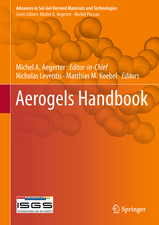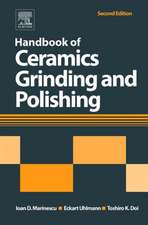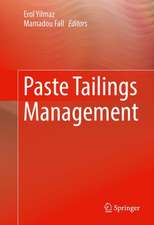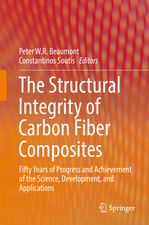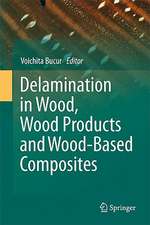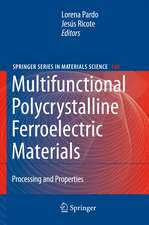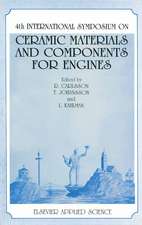Handbook of Materials for String Musical Instruments
Autor Voichita Bucuren Limba Engleză Paperback – 12 iun 2018
This book addresses core questions about the role of materials in general and of wood in particular in the construction of string instruments used in the modern symphony orchestra – violins, violas, cellos and basses. Further attention is given to materials for classical guitars, harps, harpsichords and pianos. While some of the approaches discussed are traditional, most of them depend upon new scientific approaches to the study of the structure of materials, such as for example wood cell structure, which is visible only using modern high resolution microscopic techniques. Many examples of modern and classical instruments are examined, together with the relevance of classical techniques for the treatment of wood. Composite materials, especially designed for soundboards could be a good substitute for some traditional wood species. The body and soundboard of the instrument are of major importance for their acoustical properties, but the study also examines traditional and new wood species used for items such as bows, the instrument neck, string pegs, etc. Wood species’ properties for musical instruments and growth origins of woods used by great makers such as Antonio Stradivari are examined and compared with more recently grown woods available to current makers. The role of varnish in the appearance and acoustics of the final instrument is also discussed, since it has often been proposed as a ‘secret ingredient’ used by great makers. Aspects related to strings are commented.
As well as discussing these subjects, with many illustrations from classical and contemporary instruments, the book gives attention to conservation and restoration of old instruments and the physical results of these techniques. There is also discussion of the current value of old instruments both for modern performances and as works of art having great monetary value.
The book will be of interest and value to researchers, advanced students, music historians, and contemporary string instrument makers. Musicians in general, particularly those playing string instruments, will also find its revelations fascinating. It will also attract the attention of those using wood for a variety of other purposes, for its use in musical instruments uncovers many of its fundamental features.
Professor Neville H. Fletcher
Australian National University, Canberra
| Toate formatele și edițiile | Preț | Express |
|---|---|---|
| Paperback (1) | 1422.59 lei 38-44 zile | |
| Springer International Publishing – 12 iun 2018 | 1422.59 lei 38-44 zile | |
| Hardback (1) | 2014.27 lei 38-44 zile | |
| Springer International Publishing – 7 sep 2016 | 2014.27 lei 38-44 zile |
Preț: 1422.59 lei
Preț vechi: 1847.52 lei
-23% Nou
Puncte Express: 2134
Preț estimativ în valută:
272.21€ • 284.97$ • 225.24£
272.21€ • 284.97$ • 225.24£
Carte tipărită la comandă
Livrare economică 01-07 aprilie
Preluare comenzi: 021 569.72.76
Specificații
ISBN-13: 9783319811918
ISBN-10: 3319811916
Pagini: 975
Ilustrații: XIX, 975 p. 551 illus., 362 illus. in color.
Dimensiuni: 155 x 235 mm
Ediția:Softcover reprint of the original 1st ed. 2016
Editura: Springer International Publishing
Colecția Springer
Locul publicării:Cham, Switzerland
ISBN-10: 3319811916
Pagini: 975
Ilustrații: XIX, 975 p. 551 illus., 362 illus. in color.
Dimensiuni: 155 x 235 mm
Ediția:Softcover reprint of the original 1st ed. 2016
Editura: Springer International Publishing
Colecția Springer
Locul publicării:Cham, Switzerland
Cuprins
From the Contents: Description of String Instruments for Classical Music.- Mechanical Characterization of Materials for String Instruments.- Measuring Vibration Modes of Violins’ and Other Instruments’ Plates.- Material Properties and the Modes of Vibration of the Piano Soundboard.
Notă biografică
Dr. Voichita Bucur, currently a senior visiting research fellow at CSIRO, Australia, received her bachelor in Engineering in 1962 from Polytechnic Institute Brasov, Romania, and her PhD in Mechanics and Ultrasonics in 1984 from the Institut Supérieur des Materiaux, St Ouen, Paris, France.
In Romania she was a scientist at the Wood Research Institute in Bucharest until 1978. Then she moved to France where she worked at the Forestry Research Centre in Nancy in charge of the development of acoustic (ultrasonic) nondestructive techniques for quality improvement of wood and wood based products. She was also in charge of the research programmes for PhD and MSci students at the Université "Henri Poincaré" - Nancy, France, for the development of ultrasonic technique in Wood Science. In December 2005 she retired from these positions and moved to Australia.
A member of 5 wood and acoustical societies, Dr Bucur published 6 books and more than 140 articles and other publications, shewas a reviewer for journals on wood science, and has 1 patent in France.
Her fields of research encompass development of non-destructive techniques (vibrational, acoustic, ultrasonic , X- rays) for the assessment of the quality of trees, wood products and wood-based composites, mechanical characterisation of materials with non-destructive techniques, wood science and technology, and mechanical characterisation of wood for musical instruments.
In Romania she was a scientist at the Wood Research Institute in Bucharest until 1978. Then she moved to France where she worked at the Forestry Research Centre in Nancy in charge of the development of acoustic (ultrasonic) nondestructive techniques for quality improvement of wood and wood based products. She was also in charge of the research programmes for PhD and MSci students at the Université "Henri Poincaré" - Nancy, France, for the development of ultrasonic technique in Wood Science. In December 2005 she retired from these positions and moved to Australia.
A member of 5 wood and acoustical societies, Dr Bucur published 6 books and more than 140 articles and other publications, shewas a reviewer for journals on wood science, and has 1 patent in France.
Her fields of research encompass development of non-destructive techniques (vibrational, acoustic, ultrasonic , X- rays) for the assessment of the quality of trees, wood products and wood-based composites, mechanical characterisation of materials with non-destructive techniques, wood science and technology, and mechanical characterisation of wood for musical instruments.
Textul de pe ultima copertă
This book addresses core questions about the role of materials in general and of wood in particular in the construction of string instruments used in the modern symphony orchestra – violins, violas, cellos and basses. Further attention is given to materials for classical guitars, harps, harpsichords and pianos. While some of the approaches discussed are traditional, most of them depend upon new scientific approaches to the study of the structure of materials, such as for example wood cell structure, which is visible only using modern high resolution microscopic techniques. Many examples of modern and classical instruments are examined, together with the relevance of classical techniques for the treatment of wood. Composite materials, especially designed for soundboards could be a good substitute for some traditional wood species. The body and soundboard of the instrument are of major importance for their acoustical properties, but the study also examines traditional and new wood species used for items such as bows, the instrument neck, string pegs, etc. Wood species’ properties for musical instruments and growth origins of woods used by great makers such as Antonio Stradivari are examined and compared with more recently grown woods available to current makers. The role of varnish in the appearance and acoustics of the final instrument is also discussed, since it has often been proposed as a ‘secret ingredient’ used by great makers. Aspects related to strings are commented.
As well as discussing these subjects, with many illustrations from classical and contemporary instruments, the book gives attention to conservation and restoration of old instruments and the physical results of these techniques. There is also discussion of the current value of old instruments both for modern performances and as works of art having great monetary value.
The book will be of interest and value to researchers, advanced students, music historians, and contemporary string instrument makers. Musicians in general, particularly those playing string instruments, will also find its revelations fascinating. It will also attract the attention of those using wood for a variety of other purposes, for its use in musical instruments uncovers many of its fundamental features.
Professor Neville H. Fletcher
Australian National University, Canberra
Caracteristici
Provides insights into the properties of traditional and new materials used in string instruments Richly illustrated with a large number of photographs Explains how materials and treatments can contribute to the final aesthetic and acoustical qualities of string instruments Complements the existing literature on physics and acoustics of string musical instruments Includes supplementary material: sn.pub/extras



